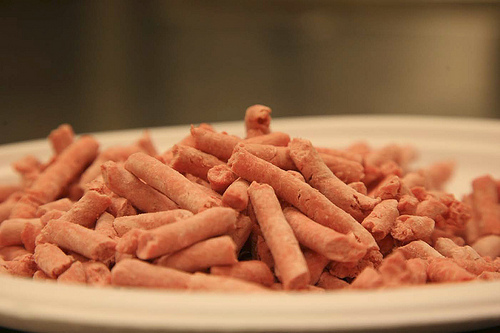
Agricultural News
Derrell Peel Takes a Long Look at the Reality and Economics of Lean Finely Textured Beef
Mon, 02 Apr 2012 14:07:55 CDT

In the wake of the media firestorm over Lean Finely Textured Beef, or "Pink Slime," as sensationalists are fond of calling it, it is easy to lose sight of the truth. In the following article, Oklahoma State University Extension Livestock Marketing Specialist Derrell S. Peel takes a long look at what LFTB really is, why it was created, and why the economics of the product are of vital importance to consumers.
Americans have an enormous appetite for hamburger. By most estimates, ground beef consumption accounts for more than 50 percent of total beef consumption. Over the past few years, both the total demand for ground beef and specifically, the demand for lean ground beef have increased. The industry has responded by providing ever higher proportions of lean ground beef, in part, by using processing technology that includes lean finely textured beef (LFTB). LFTB uses a process to remove additional fat from beef trimmings to provide a very lean beef product. The product is produced in a lowered pH environment to inhibit potential bacteria growth. LFTB is a 100 percent beef product that is extremely safe and has been used for many years. Fueled by recent sensationalized and inaccurate media depictions of this product, some consumers have indicated that they do not want ground beef products containing LFTB. Certainly it is every consumers right to decide if they wish to purchase a product or not but it is entirely possible that consumers may not like the consequences of rejecting this particular beef product.
In order to understand the implications of not using LFTB, it is essential to understand the realities of beef production and the mathematics of ground beef supply. Most of our beef supply comes from fed steer and heifer slaughter, nearly 27 million head in 2011. When fabricated into beef cuts, each of these carcasses produces several pounds of trimmings, some which are fatty trimmings that are, for example, 50 percent lean and 50 percent fat. These trimmings must have additional lean added in order to produce ground beef. Lean trimmings typically come from cull cow and bull slaughter that produces trimmings that average 90 percent lean and 10 percent fat. About 7.4 million head of cows and bulls were slaughtered in 2011, which means that the domestic supply of 90 percent trim is much smaller than the supply of 50 percent trimmings. This imbalance will be particularly acute given the anticipated decrease in cow slaughter in the next couple of years. These domestic lean trimmings are supplemented by imported lean beef products. Much of U.S. imports of beef from Australia and New Zealand is lean beef to supplement to supply of lean trimmings.
Typically, 50 percent (known as 50s) and 90 percent trimmings (known as 90s) are mixed in various proportions to produce ground beef. For example, a mixture of 35 percent 50s and 65 percent 90s results in ground beef that is 76 percent lean. However, the growing demand for lean ground beef means that more 90s are required in the market today. A mixture of 10 percent 50s and 90 percent 90s results in 86 percent lean ground beef, which is more common now. Thus the growing demand for leaner ground beef has simultaneously resulted in excess supply of 50s and increased demand for 90s.
Production of LFTB addresses both of those issues by using 50 percent trimmings and removing much of the fat to produce a very lean beef product. LFTB, which is roughly 95 percent lean, uses about two pounds of 50s to produce one pound of 95 percent lean beef. This makes it much easier to produce lean ground beef and use more 50s and less 90s as a result. For example, using 10 percent LFTB, combined with 11.25 percent 50s and 78.75 percent 90s produces 86 percent lean ground beef identical to the mixture of 10 percent 50s and 90 percent 90s described above. The difference is that the inclusion of LFTB uses over 200 percent more 50s and almost 13 percent less 90s to accomplish the same thing. LFTB puts the same lean beef that would likely end up in ground beef anyway into ground beef in a manner that uses beef more efficiently and results in a more economical product.
Rejecting LFTB will have consequences that many consumers will not like. First and foremost ground beef and especially lean ground beef will increase significantly in price as it will require more pounds of the more expensive 90s to produce ground beef. This may well contribute to the demise of the dollar menu at your favorite fast food hamburger chain-whether they use LFTB or not. This will also result in increased imports of lean beef, which may be a concern or a consequence that consumers do not like. Given concerns about rising food prices, growing global food demand and food security, we must use beef products in the most efficient manner possible. LFTB is sort of the modern equivalent of your grandmother boiling the soup bones to make beef stock. She could not afford to waste beef then and neither can we today. We have the lowest relative food prices in the world and the reason we do is because we utilize processes like LFTB to capture the maximum value of food production.
WebReadyTM Powered by WireReady® NSI
Top Agricultural News
More Headlines...



















